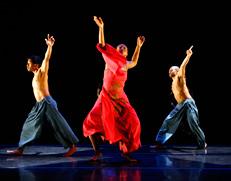Ife/My Heart, Grace, and Upside Down: human experience put to rhythm

The Brooklyn dance company, Evidence, lives up to its name. Talk about giving a lesson in showing, not telling.
The founder and artistic director of the 25-year-old company, Ronald K. Brown, has said he uses movement, sound and storytelling to stage the histories, tragedies and triumphs of the African Diaspora. What else is dance if not the human experience put to rhythm?
Evidence performance was executed with purpose and joy, with narratives sometimes prominent and lucid, other times abstract and unconscious.
In these three installations presented in Vancouver with the Cultural Olympiad, Ife/My Heart, Grace, and Upside Down, the ensemble dancers realized Brown's vision. (Brown also danced.) The movement was powerful, vigorous but sometimes at odds with the music, which spanned the entire FM radio dial from trance and house beats to pop ballads and gospel. The music was exciting, but was not always in synch with the tempo and tone of the dance. At times I found it hard to see how the songs worked in service of the story.
This first installment was my favourite. It was the most cohesive and used costuming, choreography, movement and music to reference God and religious vitality. Throughout Ife/My Heart (first choreographed by Brown for the Alvin Ailey American Dance Theatre in 2005), we see three parallel but distinct African communities and their spiritual lives. Afro-Cuban rhythms, percussion, gospel and Spanish lyrics had every part of the body in motion: hips, asses, breasts, limbs, wrists, toes and necks moving in secular sensuality. The dancers never touched. One refrain looped a choir chorus and sang of replacing bigotry with the power of prayer. Dancers fell into the foetal position at the feet of their peers, as if asking for release, God’s grace and also praising the ties of kinship.
The dress in this first installment evoked place — West Africa, the American South of the ‘30s, and mid-century Cuba — but some garments were ill fitting, unflattering and concealed dancers’ bodies and their movements. But the wardrobe was made of white, satin-like fabric that shimmered under the lights and rippled from the frantic, pulsing dance steps as if we were witnessing an evangelical revival. I kept thinking of adult baptisms on the banks of slow moving rivers.
I found the second and third installments less successful despite the energy and talent of the dancers. Some moved with languid grace; others with tension in every position. The differences almost distracted since I wanted to look at each; they were captivating in their technique and style.
Upside Down is an excerpt of the full-length dance, Destiny, which was created by Brown for the Jeune Ballet d’Afrique Noire and premiered in 1998.
In Grace (choreographed by Brown for the Alvin Ailey American Dance Theatre in 1999), the vibe is the happiest and the theme the most god-fearing. The playbill tells us there are angels and a “God/Woman” who visits Earth’s mortals to round up those who behave as if they’re clueless to God’s wisdom and compassion. Far from literal or even linear, the choreography drew on colour, costuming and light. I was mesmerized by the competitive, athletic and even antagonistic interplay between dancers dressed in red and others in white. Then suddenly, they were all wearing white, walking into the light.



